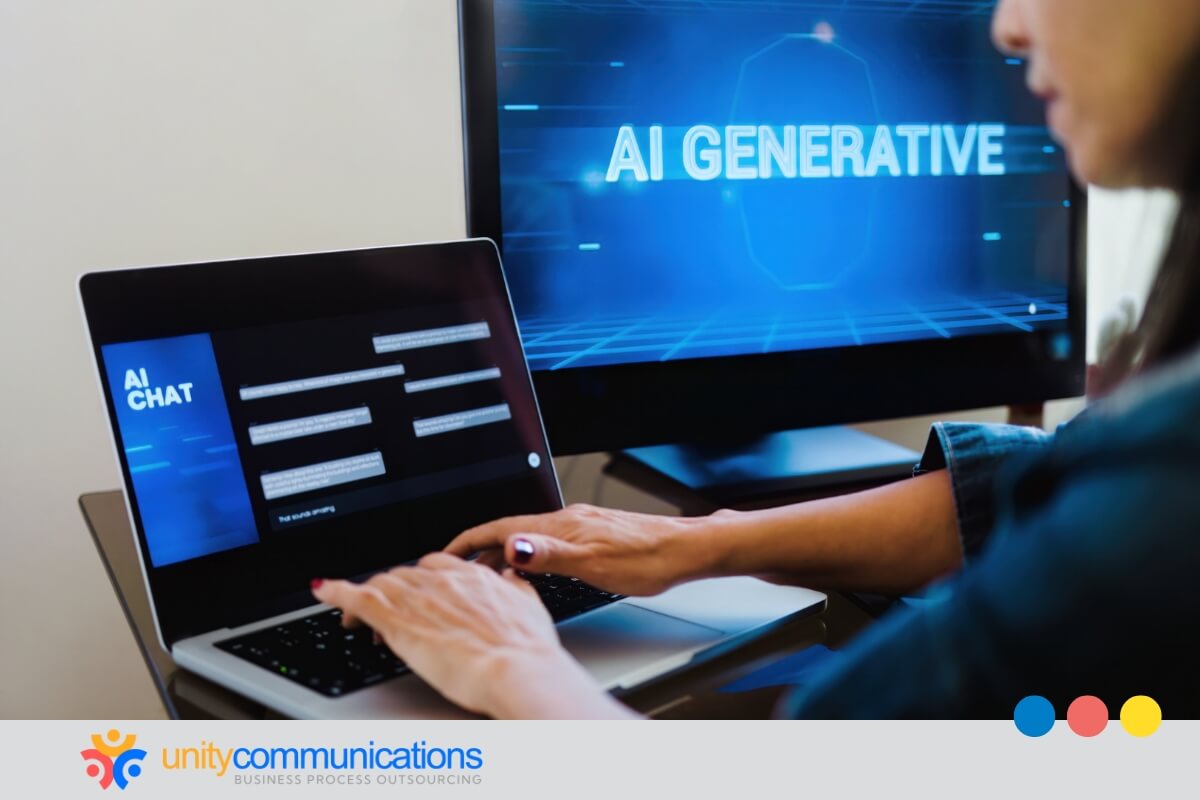Table of Contents
Artificial intelligence (AI) is pivotal in modern business, offering practical ways to improve efficiency, growth, and decision-making. Generative AI (genAI) and advanced AI agents extend these advantages beyond large corporations.
Small- and medium-sized businesses (SMBs) can access automation and insights once out of reach. Business process outsourcing (BPO) providers are also advancing with AI-driven support.
This comprehensive guide reveals how SMBs such as yours can implement AI strategically to drive growth, reduce costs, and compete more effectively.
What is generative AI, and why should businesses care?

For SMBs and startups, keeping pace with new technologies can feel overwhelming. Yet one area you cannot ignore is genAI. It is quickly moving from experimental to everyday use, and its reach expands across industries that matter to you.
GenAI explained: From complex technology to a business tool
Think of it as software that learns from massive amounts of information and produces new content that feels original. Instead of you writing an entire report, drafting emails, or designing visuals from scratch, it can generate content in seconds with remarkable accuracy.
It goes beyond text too. These systems can design product images, generate training videos, analyze contracts, and produce tailored recommendations. By combining speed with adaptability, the technology can lighten workloads that usually demand hours of staff time and specialized knowledge.
Global market projections vary but show rapid growth. MarketsandMarkets expects the AI industry to scale from $71.36 billion in 2025 to $890.59 billion by 2032. The uptrend indicates broad business adoption that extends well beyond large enterprises.
Why this technology matters for SMB decision-makers
For entrepreneurs and SMB owners, the question is less about what the technology does and more about how it supports growth. You can use it to automate content, handle repetitive support, and improve decision-making with richer insights at a fraction of the time.
McKinsey found that 71% of surveyed organizations used this AI technology in at least one business function in early 2025, up from 65% in early 2024. Adoption is broadening from early pilots to real use, which shows clear momentum toward practical deployment.
Key areas where this intelligent system can help you include:
- Marketing campaigns personalized at scale
- Drafting and refining customer responses
- Accelerating financial reporting and bookkeeping tasks
- Driving efficiency in outsourcing through BPO for small businesses as service providers explore AI-powered support
- Streamlining human resource (HR) workflows, such as job postings, resume screening, and interview scheduling
- Improving customer analytics for faster, data-driven decisions
These opportunities directly address challenges SMBs face daily. You gain faster output, more consistent quality, and tools to help you compete with larger players who traditionally held the advantage.
As adoption widens, your ability to apply it effectively can become a defining factor in your business’s growth.
How genAI works: The business owner’s guide
When you hear about generative AI, the inner workings can sound intimidating. At its core, it teaches systems to recognize patterns, learn from vast information, and produce fresh outputs. The concept might seem technical, but the practical flow is straightforward.
Why data quality determines your AI success
Think of this process as training an employee. The more examples they see, the better they perform. AI follows a similar path by processing millions of records, images, or conversations. Data quality affects its accuracy, reliability, and relevance to your operations.
Large volumes of structured and unstructured data feed into models, helping them identify context and meaning. For SMBs, that means they can personalize outputs. Whether you are analyzing contracts or forecasting sales, better data means more valuable outcomes.
How AI models learn to generate outputs from patterns
These systems rely on algorithms that adjust themselves as they encounter new data. They spot recurring relationships, predict likely results, and deliver unique content to your needs. Over time, they improve through feedback, which sharpens speed and precision.
This mirrors how robotic process automation (RPA) functions in back-office work. Just as RPA eliminates repetitive manual steps, genAI learns from patterns to take on creative or decision-driven tasks that generally require human effort.
For you, this can be:
- Drafting a marketing campaign tailored to customer behavior
- Summarizing customer feedback from multiple channels into actionable insights
- Producing financial summaries with minimal oversight
- Generating contract drafts that align with compliance standards
- Preparing BPO vendor performance reports for outsourcing evaluation
- Recommending personalized training materials for staff development
- Drafting job descriptions that match evolving role requirements
- Suggesting inventory adjustments based on demand shifts
The beauty of the process is that these outputs are not random. They follow logical patterns grounded in data.
When you supply the right inputs, the results are more accurate and directly aligned with your business goals. As adoption spreads, your ability to understand the basics of how these systems function helps you decide where they add the most value.
Knowing how the models learn makes it easier to pinpoint which tasks you should delegate to technology and which remain best handled by your team.
What types of models matter most for business use?
Not all AI models function the same way, and their strengths vary depending on your goals. For business leaders, the focus should be on which approaches deliver the clearest impact across operations.
Understanding how different systems work helps you spot where generative AI brings the most value.
Key model types every business leader should know
Some core model categories stand out in practical business use:
- Large language models (LLMs) can draft reports, generate insights from documents, and support customer interactions in natural language.
- Multimodal models combine text, images, and audio for marketing, product design, and customer experience.
- Recommendation models suggest next steps, products, or services based on customer data and preferences.
- Predictive models forecast sales, demand, or risk using historical and real-time data.
- Conversational agents power virtual assistants or support chatbots that adapt to context and provide human-like responses.
These models equip you to tackle business challenges with precision. By knowing what each type delivers, you can match the right model to your goals, helping your business run smarter, save time, and stay relevant.
Matching AI model types to everyday business needs
Selecting the right type for your business depends on the challenge you want to address:
- A language model can help you respond faster if you manage large volumes of customer messages.
- Recommendation engines increase sales in retail or e-commerce by aligning offers with customer behavior.
- Predictive models are well-suited for finance and operations because they give clearer visibility into potential risks and opportunities.
- Multimodal models are beneficial if you need content that blends visuals with insights, such as product listings, ads, or training materials.
- Conversational agents help reduce support costs while maintaining responsiveness.
What matters most is aligning the model’s capabilities with a tangible business outcome. Instead of trying to use every option, you benefit more by starting small and expanding based on proven value.
With genAI, the flexibility to shift between creative content, customer insights, and operational tasks makes it practical for many functions. Recognizing which models best suit your needs can help you make smarter investment decisions.
The right match lets you address immediate goals while preparing your business to adopt more advanced capabilities as they mature.
Real-world success stories: How businesses use AI today
The influence of genAI is already visible across industries where efficiency, speed, and personalization drive competitive advantage. What once felt experimental is now shaping real-world results.
For SMBs, the lesson is clear: you can draw insights from how larger enterprises put these tools into practice.
Industry examples driving adoption today
Executives worldwide are moving from curiosity to active trials. A 2023 Gartner survey of over 1,400 leaders showed that nearly half are testing generative tools, and about one in ten already run them in production. This signals strong momentum that goes beyond hype.
Key areas where enterprise adoption is taking hold include:
- Financial services using AI to detect fraud patterns before they escalate
- Healthcare applying models for diagnostic support and patient communication
- Retail companies deploying AI to fine-tune pricing and manage supply chains
- Manufacturers leveraging predictive systems for maintenance and process optimization
- Customer experience teams exploring outsourcing contact centers to the cloud, powered by AI
- Marketing departments generating personalized campaigns and content at scale
- Legal teams applying AI for contract review and compliance checks
These moves highlight that generative systems are not just experimental projects. They are shifting how entire sectors operate.
Practical takeaways SMBs can apply from enterprise use
While large corporations often lead adoption, you can adapt many of their approaches to fit smaller-scale operations. The key is to focus on practical value, not big budgets.
Ways you can apply these lessons include:
- Use AI-driven insights to streamline bookkeeping and reporting tasks.
- Adopt simple chat-based systems to handle routine customer inquiries.
- Apply recommendation models to personalize offers for repeat buyers.
- Use content generation for training, HR onboarding, and service provider communication.
- Run predictive analysis to guide purchasing and reduce inventory waste.
- Leverage AI to schedule appointments, reminders, and follow-ups automatically.
- Apply AI tools to improve recruitment screening and candidate selection.
These use cases show that the benefits extend well beyond global enterprises. They give you a practical roadmap for gradual adoption, focusing first on areas where returns are easiest to capture.
By observing how leading industries deploy generative AI, you can pinpoint opportunities to scale smarter. The advantage comes from adopting what fits your business needs today while preparing for wider integration tomorrow.
What are the key benefits for business growth?

For SMBs and startups, investing in new technology can feel risky. Yet genAI offers tangible advantages that go beyond efficiency.
Understanding these benefits helps you focus on areas where investment delivers measurable returns. You can apply a cost-benefit analysis of outsourcing to decide where AI adds the most value and aligns with your strategic goals.
Cost savings and efficiency opportunities
AI adoption provides opportunities to streamline operations, reduce errors, and save time and money. Studies show that some firms report cost reductions exceeding 10% in targeted service areas, while others achieve smaller gains.
According to Bain and Company’s 2024 Automation Scorecard, leading companies achieved 22% cost reductions through automation in 2023, while companies just beginning their automation journey saw more modest 8% improvements.
This means the benefits lie in cutting costs and reallocating resources to higher-value work. These gains improve efficiency without increasing headcount, which benefits smaller teams. You can also:
- Reduce administrative overhead and manual reporting.
- Accelerate invoice processing and expense management.
- Improve response times in customer service and support.
- Minimize errors in routine data entry and documentation.
You can combine BPO advantages with AI to enhance workflows, automate repetitive tasks, and boost output in finance, HR, and customer support.
Growth advantages unique to smaller businesses
The impact of genAI is most substantial for SMBs, giving you the flexibility to scale quickly and compete with larger competitors.
The latest research on SMB trends shows 87% claim that AI helped them expand their services, which shows that adoption is practical and achievable. You can leverage these advantages to:
- Extend service offerings without proportionally increasing staff.
- Automate marketing campaigns and customer engagement.
- Generate insights for faster, data-driven decisions.
- Adapt to changing market conditions or customer preferences.
- Support remote or hybrid teams with streamlined workflows.
- Improve cross-team collaboration through AI-assisted project tracking.
- Personalize client communications to strengthen relationships.
- Enhance vendor and supplier management by automating performance tracking and timely communications.
- Streamline inventory planning with predictive insights.
By thoughtfully adopting AI tools, you gain more than incremental improvements. Efficiency gains, cost reductions, and growth opportunities give your business a practical path to scale.
These benefits allow you to capture opportunities faster, make informed decisions, and position your organization for sustainable success in a competitive market.
What challenges and risks should you watch out for?
Generative AI offers significant opportunities, but adoption is not without challenges. SMBs must understand potential risks to avoid costly mistakes and achieve smooth integration.
Awareness of these issues allows you to plan proactively, balance opportunity with responsibility, and maintain control as you scale.
Common pitfalls in adopting new AI tools
A recent industry report found that about 21% of companies were dissatisfied with genAI results when scaling, mainly because of unexpected costs or integration issues. Many firms also lack mature governance, which raises risk.
These insights also highlight why assessing BPO risks and drawbacks is essential before adopting AI. Common pitfalls you should watch for include:
- Misaligned expectations between leadership and staff on AI capabilities
- Insufficient training or understanding of AI tool functions
- Overestimating potential time and cost savings without pilot testing
- Integration issues with existing software or workflows
- Limited oversight or governance leading to inconsistent outputs
- Poorly defined key performance indicators (KPIs) make evaluating success difficult
- Choosing tools without proven enterprise or SMB track records
- Ignoring feedback loops that help refine AI outputs over time
By recognizing these pitfalls early, you can create a structured adoption plan that avoids common missteps, protects investments, and sets clear success metrics for your SMB.
Managing costs, accuracy, and security concerns
To safely capture the benefits of this AI technology, you must actively manage cost, accuracy, and security risks. SMBs can implement practical steps to maintain reliability, safeguard sensitive data, and control budgets.
- Track and manage subscription or licensing costs to prevent overruns.
- Regularly audit outputs for accuracy and relevance to your operations.
- Set up human review processes for critical outputs.
- Protect sensitive data with secure storage and compliant platforms.
- Monitor AI usage to detect anomalies or unexpected behavior.
- Train staff on best practices for interacting with AI systems.
- Establish escalation paths for errors or unexpected AI outputs.
- Ensure AI-generated content complies with industry regulations and internal policies.
- Limit access based on role or sensitivity of data processed by AI.
- Document processes and create clear guidelines for AI-assisted decision-making.
Taking these steps allows you to deploy AI responsibly. By addressing costs, quality, and security upfront, you reduce risk while capturing efficiency, productivity, and growth opportunities for your business.
How should leaders approach ethics and governance?
As genAI becomes more integrated into business operations, you must address ethics and governance to safeguard trust and compliance. For SMBs, it is critical to balance innovation with accountability so that AI tools support decision-making.
Awareness of ethical considerations lets you guide teams responsibly, anticipate challenges, and seize the opportunities and challenges of integrating AI in outsourcing. Establishing clear principles early prevents missteps and supports sustainable AI adoption.
Building customer trust with responsible AI use
Maintaining credibility with clients requires a visible commitment to ethical AI practices. You can take practical steps to foster trust:
- Clearly inform customers when AI contributes to decisions or content.
- Ensure outputs are accurate, unbiased, and tailored to client needs.
- Maintain human oversight for critical decisions.
- Collect and act on customer feedback to refine AI interactions.
- Train employees to interpret AI-generated outputs responsibly.
- Limit automation in high-stakes or sensitive interactions.
- Establish guidelines that reflect your company’s ethical standards.
- Monitor AI performance regularly to identify errors or inconsistencies.
- Protect confidential customer data throughout AI workflows.
- Document processes to demonstrate accountability.
- Provide transparency about the AI models and data sources you use.
- Set clear internal policies for AI-driven communications.
- Encourage open discussion with clients about AI limitations.
Taking these steps shows your clients that your use of genAI is deliberate, transparent, and aligned with their interests. This strengthens loyalty and builds confidence in your services.
Compliance and regulatory issues to prepare for
Legal and regulatory requirements vary across industries, making proactive governance essential. Key measures include:
- Understanding applicable data privacy and protection laws
- Auditing AI outputs to ensure adherence to standards
- Establishing accountability for AI-driven decisions
- Maintaining traceable records of AI data sources and training
- Reviewing service provider compliance before integrating third-party AI tools
- Defining AI responsibilities in contracts and service agreements
- Monitoring for intellectual property risks in AI outputs
- Preparing for audits or regulatory assessments
- Updating internal policies as AI regulations evolve
- Training teams on compliance expectations
- Conducting regular internal reviews of AI ethics practices
- Attaining cross-department alignment on AI responsibilities
Addressing these regulatory requirements enables you to deploy AI confidently. By integrating governance practices, you reduce legal and operational risk and ensure that AI adoption supports sustainable, compliant growth for your business.
How can you integrate it with systems you already use?
For SMBs, adopting genAI is learning what the technology does and embedding it into the platforms, workflows, and services you already depend on. Integration can feel complex, yet it brings efficiency and measurable gains when approached step by step.
Aligning new tools with current systems means adoption supports growth rather than disrupting daily operations. You can confidently integrate AI into your business processes by focusing on compatibility and clear outcomes.
Practical steps for AI adoption in SMB operations
Integration works best when you follow structured steps. In PwC’s October 2024 Pulse Survey, almost half of information technology (IT) executives said they have fully embedded AI into their companies’ core strategy. This highlights the momentum of adoption and shows how practical planning drives results.
Ways you can apply integration include:
- Map clear objectives for each integration effort.
- Start with pilot projects that connect AI to one or two processes.
- Assess compatibility between existing platforms and AI tools.
- Collect staff input to align adoption with operational needs.
- Define metrics to measure the value of adoption.
- Introduce change management support for smooth rollout.
- Involve cross-functional teams to strengthen adoption readiness.
- Track vendor updates and AI model improvements to keep systems current.
- Use iterative testing to refine system compatibility.
- Document integration workflows for repeatability and future scaling.
- Partner with external experts or third-party contractors when internal capacity is limited.
Following these steps helps you integrate systems without overwhelming teams. With a structured approach, you capture value faster and identify what scales best across your organization.
Choosing the right tools and service providers for your needs
Technology adoption is not one-size-fits-all. You must select solutions that fit your budget, operations, and goals. The right partner reduces complexity, while the wrong one adds risk. Focus on clarity, scalability, and transparency when choosing tools.
Consider these points:
- Evaluate service providers with proven experience in SMB markets.
- Review security standards and data handling practices.
- Select BPO organizations that align with your industry’s regulatory requirements.
- Compare costs against projected benefits before committing.
- Ask about integration support and training resources.
- Check providers’ track records with AI adoption in 2024.
Choosing wisely allows you to integrate genAI into your existing systems while strengthening productivity and competitiveness.
Can outsourcing help you adopt genAI faster?

You want to capture the benefits of generative AI, but building expertise in-house can take time and strain resources. Outsourcing gives you faster access to skills, technology, and support models that accelerate adoption.
For SMBs, the right partners turn complex projects into practical outcomes. When outsourcing, you must also understand what BPO is in today’s context. It has shifted beyond back-office work and now includes advanced AI-driven functions.
Service providers are no longer just handling support tasks. They help businesses deploy intelligent solutions that align with growth strategies. Understanding how outsourcing works when integrating new technology is also essential.
BPO services augment your team with expertise and tools, helping you scale quickly while avoiding the overhead of hiring, training, and managing staff.
Outsourcing models for AI adoption explained
Not every model fits all business needs. You should explore approaches that match your scale and goals.
A recent study reveals that 20% of businesses are building a strategy for a digital-ready workforce, while 83% of executives expect AI-driven outsourcing from third-party vendors. This indicates strong momentum toward external support.
Key outsourcing models include:
- Staff augmentation for short-term AI projects
- Managed services for continuous AI system monitoring
- Project-based outsourcing for defined AI implementations
- Hybrid models that mix internal teams with external providers
- Cloud-based outsourcing that provides scalable AI access
- Onshore, nearshore, or offshore partnerships based on cost and control
- AI consulting services that guide adoption and strategy
- AI and BPO collaborations that merge automation with human expertise
Each approach has unique benefits, so choosing depends on budget, goals, and required flexibility.
When to partner with service providers vs. an in-house team
You might wonder when to keep AI adoption internal or work with outside experts. Both paths have value, and the choice depends on your priorities.
Key considerations include:
- Costs of building long-term AI expertise internally
- Urgency of deployment and time-to-value expectations
- Access to specialized skills and vendor partnerships
- Ability to maintain regulatory and compliance oversight
- Scalability of systems as your business grows
- Long-term control over proprietary processes and data
- Resource availability for training and maintenance
- Balancing outsourcing vs. offshoring for optimal cost and expertise
Finding the right mix lets you integrate generative AI effectively while staying agile.
What does the future hold for business success?
The pace of adoption is accelerating, and the question for you is how to position your business for what comes next. Success depends on adopting the right tools and anticipating shifts in outsourcing, technology, and customer expectations.
By looking ahead, you can see where opportunities are emerging and prepare to capture them.
Trends shaping the next wave of AI adoption
Practical priorities and market readiness will guide the next phase of adoption. BPO trends and predictions show that outsourcing partners are expanding services beyond cost savings to strategic AI partnerships, opening new opportunities for SMBs to scale effectively.
Key shifts to expect include:
- Growth of industry-specific AI models tailored for finance, healthcare, logistics, manufacturing, and retail
- Wider adoption of AI-powered customer engagement platforms across SMBs
- Expansion of AI-driven business process outsourcing agreements and contracts that merge automation with human oversight
- Rising demand for AI governance services to address compliance and ethics
- Broader access to affordable subscription-based AI for smaller companies
- Increased collaboration between BPO providers and technology vendors to support SMB adoption
- Development of multilingual AI support to serve global or regional markets
- Shift from experimental pilots to measurable, long-term outsourcing commitments
These trends highlight the importance of choosing partners and models that align with one’s short-term needs and broader goals.
Preparing your business for long-term AI growth
Positioning your business for success means planning for sustainable growth. Instead of short bursts of experimentation, you need strategies that extend across your operations and teams. This is where preparation meets opportunity.
Practical steps include:
- Build a roadmap that aligns AI adoption with business priorities.
- Allocate resources for ongoing staff training and adaptation.
- Set performance benchmarks to track operational and financial impact.
- Partner with offshore outsourcing companies that adapt tools for SMB scale and budget.
- Integrate compliance and security planning into every adoption stage.
- Establish internal governance structures to maintain accountability.
- Diversify outsourcing models to balance flexibility with control.
- Leverage feedback loops from employees and customers to refine adoption.
- Explore AI-as-a-service platforms that provide scalable access without heavy upfront investments.
By preparing thoughtfully, you create conditions where genAI supports efficiency, competitiveness, and sustainable growth. Long-term readiness gives you a stronger foundation for capturing opportunities as market dynamics shift.
The bottom line
Generative AI is practical now for SMBs. Pair it with the right processes and BPO partners to scale capability, not just workload.
The question isn’t whether AI will reshape your industry. It’s whether you’ll lead the change or react to it. SMBs that implement genAI strategically today will have significant competitive advantages tomorrow.
Ready to explore how generative AI can accelerate your growth? Let’s connect to design a focused pilot, select metrics, and establish a compliant, ROI-tracked rollout.




